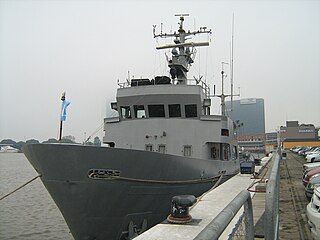
Onofre Betbeder (1862 – 24 January 1915) was an Argentine vice-admiral who had been twice-appointed Minister of the Navy. [1] [2] The Betbeder Islands are named for him. [3] [4]

Argentina, officially the Argentine Republic, is a country located mostly in the southern half of South America. Sharing the bulk of the Southern Cone with Chile to the west, the country is also bordered by Bolivia and Paraguay to the north, Brazil to the northeast, Uruguay and the South Atlantic Ocean to the east, and the Drake Passage to the south. With a mainland area of 2,780,400 km2 (1,073,500 sq mi), Argentina is the eighth-largest country in the world, the fourth largest in the Americas, and the largest Spanish-speaking nation. The sovereign state is subdivided into twenty-three provinces and one autonomous city, Buenos Aires, which is the federal capital of the nation as decided by Congress. The provinces and the capital have their own constitutions, but exist under a federal system. Argentina claims sovereignty over part of Antarctica, the Falkland Islands, and South Georgia and the South Sandwich Islands.
The Betbeder Islands are a group of small islands and rocks in the southwest part of the Wilhelm Archipelago, 35 kilometres (22 mi) west of Cape Tuxen. They were discovered by the French Antarctic Expedition, 1903–05, and named by Jean-Baptiste Charcot for Rear Admiral Onofre Betbeder, Argentine Navy.
Betbeder was born in Argentina and entered the military as a midshipman. As Minister of the Navy, he was concerned with improving the education of naval officers, and increasing the efficiency and operating standards of the naval department. [1] In 1915, he was serving as Chief of the Argentine naval commission to the U.S. when he died at his residence in New York City.
A midshipman is an officer of the junior-most rank, in the Royal Navy, United States Navy, and many Commonwealth navies. Commonwealth countries which use the rank include Canada, Australia, Bangladesh, Namibia, New Zealand, South Africa, India, Pakistan, Singapore, Sri Lanka, and Kenya.

The City of New York, usually called either New York City (NYC) or simply New York (NY), is the most populous city in the United States. With an estimated 2017 population of 8,622,698 distributed over a land area of about 302.6 square miles (784 km2), New York is also the most densely populated major city in the United States. Located at the southern tip of the state of New York, the city is the center of the New York metropolitan area, the largest metropolitan area in the world by urban landmass and one of the world's most populous megacities, with an estimated 20,320,876 people in its 2017 Metropolitan Statistical Area and 23,876,155 residents in its Combined Statistical Area. A global power city, New York City has been described as the cultural, financial, and media capital of the world, and exerts a significant impact upon commerce, entertainment, research, technology, education, politics, tourism, art, fashion, and sports. The city's fast pace has inspired the term New York minute. Home to the headquarters of the United Nations, New York is an important center for international diplomacy.
The Betbeder Islands are part of the Wilhelm Archipelago, off the west coast of Antarctica. They were discovered in 1903–1905 by a French expedition and named for Betbeder. [3] [4]

The Wilhelm Archipelago is an island archipelago off the west coast of the Antarctic Peninsula in Antarctica.

Antarctica is Earth's southernmost continent. It contains the geographic South Pole and is situated in the Antarctic region of the Southern Hemisphere, almost entirely south of the Antarctic Circle, and is surrounded by the Southern Ocean. At 14,200,000 square kilometres, it is the fifth-largest continent. For comparison, Antarctica is nearly twice the size of Australia. About 98% of Antarctica is covered by ice that averages 1.9 km in thickness, which extends to all but the northernmost reaches of the Antarctic Peninsula.













